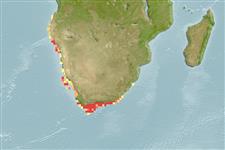>
Centrarchiformes (Basses) >
Cheilodactylidae (Morwongs)
Etymology: Cheilodactylus: Greek, cheilos = lip + Greek, daktylos = finger (Ref. 45335); referring to the fleshy lips and the lower, unbranched pectoral-fin rays (Ref. 120445).
More on author: Lacepède.
Environment: milieu / climate zone / depth range / distribution range
Écologie
marin; saumâtre démersal; profondeur 1 - 120 m (Ref. 120445). Subtropical
Southeast Atlantic: Namibia to Natal, South Africa.
Taille / Poids / Âge
Maturity: Lm ? range ? - ? cm
Max length : 30.0 cm TL mâle / non sexé; (Ref. 9492); common length : 20.0 cm TL mâle / non sexé; (Ref. 9492)
Description synthétique
Clés d'identification | Morphologie | Morphométrie
Épines dorsales (Total) : 17 - 19; Rayons mous dorsaux (Total) : 23 - 25; Épines anales: 3; Rayons mous anaux: 9 - 11.
Mainly in shallow water among rocks, but sometimes caught down to 120 m depth. Feeds on small crabs, mollusks, worms, and other small invertebrates (Ref. 9492). Tidepools apparently an important nursery habitat for juveniles (Ref. 120445),
Life cycle and mating behavior
Maturité | Reproduction | Frai | Œufs | Fécondité | Larves
Smith, M.M., 1986. Cheilodactylidae. p. 667-668. In M.M. Smith and P.C. Heemstra (eds.) Smiths' sea fishes. Springer-Verlag, Berlin. (Ref. 5319)
Statut dans la liste rouge de l'IUCN (Ref. 130435: Version 2024-1)
Menace pour l'homme
Harmless
Utilisations par l'homme
Can't connect to MySQL database (fbapp). Errorcode: Too many connections
